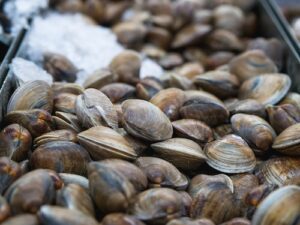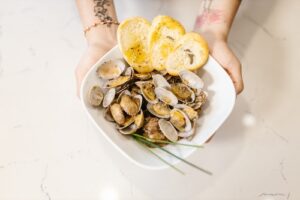Let’s talk about one of our favorite mollusks. CLAMS! We want to take a deep dive into what makes fresh clams a popular ingredient, and then look into the best ways to prepare our favorite bivalves. This blog will look at all sorts of determining factors to help make you a fresh clam expert by the end of it. Like all other seafoods and many other types of food, fresh clams are preferable. They have the most flavor, will provide an experience that can’t be matched by frozen clams, and will have the best results through the cooking process.

How to Tell If Fresh Clams Are Good to Eat
One of the most important factors when selecting fresh clams is whether they are still good to eat. Tap the shell of an open clam, and if it closes, it is still good and can be prepared for eating.
At A Fish Market
No matter how you like to eat clams, when you go to your local fish market or seafood counter, the clams that are for sale should be alive. This is the only way to ensure the clams are fresh and good for consumption. They should have a fresh smell of the ocean, of the saltwater or salty air, and the scent should be clean. If you’re searching for how to tell if clams are good to eat, make sure you check the smell first and foremost.
If you are at home and are checking clams you purchased earlier, then having a bowl of water can help to determine this. Once you have a bowl of water ready, put the clams in the water and check for those that float. Only eat the clams that float to the top of the bowl. Shells should be checked for cracks, missing pieces of shell, and other damage.
Frozen Clams
If your clams have been frozen, they will often survive the freezing process and can still be used, but they should be checked after thawing in the same way that any others are checked so that you know how to eat clams that have been frozen. Next, go through the steps to check that they are alive, and from there you can choose your clams.
Those that are stored in mesh bags in the tank should have a date of harvest attached on a tag, or you can ask the staff in that area. When they are stored at the market, they will be over ice to keep them fresh.
How to Tell Whether Clams Are Alive?
You may have always been wondering, are clams alive when you buy them? The easiest way to tell if a clam is alive, and therefore edible, is to tap on the shell of an open clam and see if it closes. You will instead look for some movement or response to tapping on it. If it closes, then it is still alive and you can eat it.
If the clam shows no movement when you tap it, or if it stays shut and you can easily open the clam, then it should be thrown away. They should be kept in the fridge only for a short period of time, no more than two days, and cooking them the day you get them is best.
How to Prepare Raw Clams
Handle raw clams with care. Begin by disposing of any that are not alive or have damaged shells. You will need to clean them before cooking, both inside and out. Begin with rinsing them under cool water and scrubbing the outside of the shell with a brush. You will need to remove all build-up from the shell, including debris and any barnacles.
Purge Saltwater
Once the outside of the shells has been cleaned, the clams must be purged in saltwater. To do this, place 1/3 of a cup of salt into a bowl or container with one gallon of water and allow them to soak for half an hour. This will rinse the sediment from the clams as they pull the water in and expel the sediment with the water. If they seem to still have sand present after the first soak, you can repeat this process once or twice more. At the end of the half hour, use a slotted spoon to lift them from the water. Place them into a colander while you dump the water. If you see any start to float, you can remove and discard those clams. Rinse the clams in the colander under cool water to remove any remaining sediment and remove the saltwater.
Cooking Clams
There are many ways to prepare clams. Once you clean and purge them, they are ready for the final steps. One of the most popular ways to cook fresh clams is to steam them. Steamed clams are a delicacy in many places across the world. Simply put them into a steamer or a colander, and ensure you expose them to the steam for two minutes. Once steaming is complete, shake them a few times, at which point the clams should all be open. Alternatively, cook them in an already hot sauce or liquid, as is often the process with pasta dishes where you add the clams to the sauce for the last few minutes before the fresh clams are poured over the pasta. If you are wondering how to tell if clams are cooked and ready to eat, the answer is simple! The shell opens. If the shell does not open during cooking, the clam should not be eaten. So, here’s the answer to the question “How do you know when clams are done?” Make sure the shell is open!
How to Eat Clams
Once your fresh clams are cooked, there are many delicious ways to serve them. One classic option is to simply serve them with a side of melted butter and lemon wedges. Allowing guests to dip the clams into the butter and squeeze a bit of lemon juice over them for a burst of freshness is a great approach. Another popular method is to serve them in a flavorful broth. Try making one with white wine, garlic, and herbs such as parsley and thyme. This broth is perfect to dip crusty bread into, making for a satisfying and delicious meal. Clams are perfect to add to pasta dishes or chowders. They are perfect for lending their briny flavor to the dishes. Insider tip: if you’re making clam chowder, make sure to check out the best things to serve with clam chowder here. With so many options, it’s easy to see why fresh clams are such a beloved ingredient in many kitchens.

Pier Market on PIER 39
Pier Market is the best place to get clam chowder in San Francisco. There are several reasons for this. One of the reasons is the restaurant’s commitment to sourcing only the freshest, highest-quality ingredients for its dishes. The seafood in Pier Market’s chowder is sustainably sourced, ensuring that they are both delicious and responsibly harvested. Additionally, the clam chowder is made from scratch daily on-site. We use a traditional recipe that we have perfected with decades of practice. Customers can taste the care and attention that goes into each bowl. Each bowl is full of tender clams, creamy broth, and chunks of hearty potatoes. Finally, Pier Market’s location on the famous PIER 39 provides the perfect setting for enjoying a warm, comforting bowl of clam chowder while taking in the sights and sounds of the bustling harbor (not to mention, it’s a great place to host a birthday party!). Interested in learning more about the best clam chowder in San Francisco? Check out the origins of clam chowder.
